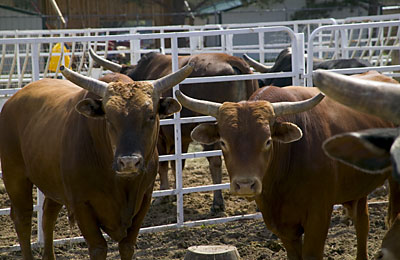Ken's Journal
No. 4 - Summer 2004
Cheyenne Frontier Days, Cheyenne WY - 07/25 - 07/30/2004
Days 29-34 on the road. Part I.
Moab UT to Cheyenne WY - 454 miles through some of the most beautiful parts of our country. Thirty-two miles north of Moab on US191, you hit I70. Take that east some 350 miles to Denver then take I25 north the rest of the way to Cheyenne.
I70 passes by such towns as Parachute, Rifle, Silt, Glenwood Springs, Eagle, Avon and Vail. This stretch of I70 has some of the most amazing engineering to be seen on any interstate. I70 shares many narrow canyons with the Colorado River, the Union Pacific railroad and, strangely enough, a paved bike path - perhaps built as a concession to the local tree-huggers. In many places, the canyons are so narrow, the eastbound lanes are on grade, while the westbound lanes are elevated on piers and are over the eastbound lanes in places. In one narrow stretch, the eastbound lanes cross to the other side of the river and tunnel through the rock cliffs.
Some 30 miles east of Vail, I70 starts a 10 mile climb from an elevation of 9,000 feet that culminates in a crossing of the Continental Divide at an elevation of 12,500 feet. After a short descent, I70 dives through the mile long Eisenhower Tunnel and starts the long descent to Denver, some 45 road miles away.
So what is Cheyenne Frontier Days? Well, besides 9 days of Professional Rodeo, there's several parades downtown, free pancake breakfasts, one of the largest carnivals I've ever seen, nightly entertainment including a couple nights of Professional Bull Riders and name Country Western stars like George Strait, Randy Travis, Amy Dally, Brad Paisley, Chris Cagle, Keith Urban, Trick Pony, Kenny Chesney . . . . There's also an Indian Village featuring Indian dancers, drummers and singers from the Wind River Reservation, a chuck-wagon cooking competition, and a Western art show and sale. The big draw for most, is of course, the rodeo.


Dress in your best western finery 'cause everyone's looking at you!
The horse on the left is part of a team pulling a wagon-load of tourists on a tour behind the chutes. What are the chutes? Those are the pens on one side of the arena where the cowboys board their rides - buckin' broncos or bulls. What's behind the chutes? There's a complex of modular pens, gates and passageways where the hundreds of wild horses, bulls and steers needed for nine days of rodeo are confined and managed before and after their premier appearances in the arena. The steers on the right are waiting their turn to try to elude some cowboy's rope.






